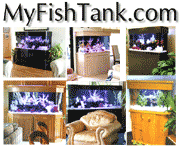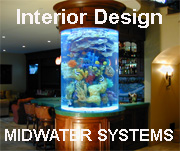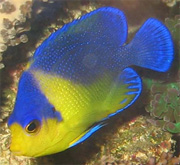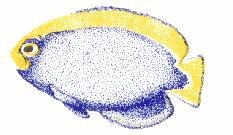|
My Experience with Gorgonian’s,
Basic Care and Selection
By Alex Silber
Of the many coral selections made available to us some of my favorite’s
are the photosynthetic gorgonians from the Caribbean. Here are five choices
I can suggest to request and purchase; Purple Frilly ( Psuedoterogorgia
elisabethae ), Silver Sea Plume ( Pseudopterogorgia aceros ), Sea Rod (
Plexaurella sp. ), Silver Gorgonian ( Muricea laxa ), and the Golden Sea
Bush ( Muriceopsis sulpherea ). I chose these because of their availability
and my successful experience with culturing them. Each of these species
is still alive and have been growing in my aquarium grown 16 to 32 months.
As mentioned by various other authors, their needs are few and simple.
" Give them strong water and light ". As an example, to give you an idea
as to what is meant by " strong water movement ", I use a Rio 90 Powerhead
pointed at a six inch tall gorgonian about one foot away. Giving the gorgonian
the correct adjusted amount of water movement will assist with discarding
its shedding skin. This shedding skin is a protective reaction which occurs
on a regular basis a few times a month. This important point is key to
its survival, otherwise undesirable algae’s will settle on their branches
and begin to spread, eventually smothering the specimen.
In my experience metal halide lighting works, but their intensity isn’t
necessary. VHO fluorescence, or Power Compacts seem to work the best.
Although it is unnecessary to feed them directly, they do have the ability
to take in particulate matter such as finely crushed flake food. Stirring
the live sand bed also works well for feeding purposes, and perhaps helps
them grow faster. Even though with these corals smooth sailing is usually
the case, there are as always, some obstacles to be aware of. Keep in mind
not to place them next to stinging neighbors such as Elegance, Bubble and
Hammer Coral. Some non-stinging corals such as Pulsing Xenia and various
leather species can inadvertently harm them as well.
Pulsing Xenia’s have an annoying tendency to take the most direct path
to wherever they are going. And in doing so they’ll climb over whoever
is in their way, sometimes smothering them in the process. If you notice
a colony approaching your gorgonian, place a small rock in front of it.
Once on the rock they can be relocated. Another point of interest comes
to mind when I think of a recently introduced gorgonian that was damaged
when the shedding skin of a neighboring large leather Coral landed on it.
This skin should have been removed immediately with a small pipette. Although
irritated, the gorgonian, which remained closed for over a week, recovered
without serious damage. I cant help but wonder if left unchecked would
the damage have been more severe ? I have since relocated the gorgonian.
Also learn to identify a little bleach white nudibranch occasionally
found hitch-hiking on the Purple Frilly gorgonians. They are tiny but don’t
let that fool you into disregarding them. They can kill your gorgonian
in a few days. This I experienced firsthand. For more information on this
‘ little bugger ’, look on page 304 of "The Reef Aquarium", Volume One.
There is a picture of it on a Purple Frilly.
The importance of selecting a healthy appearing specimen to begin with
should not be underestimated. I suggest purchasing a gorgonian that is
pre-mounted to a base with an Underwater Epoxy or naturally attached to
a rock with its own holdfast. Examine it for any visible deterioration
along its main branches, although if the tissue on the tips has receded,
even as much as an inch, this in itself is no major concern. This problem
is easily remedied by cutting the tips off with scissors a ¼" beyond
the dead area into the healthy tissue. Cutting beyond the dead area into
the tissue could prevent a bacterial infection or protozoan attacks which
may have started to take due to the open wound. The tip damage may simply
be due to physical abrasion and the accompanied stress from handling and
transportation.
Once these precautionary measures are taken into account, and the stress
of transporting and introduction into your aquarium has passed (
approximately 1 week ), gorgonians can be an excellent addition to your
mini reef aquarium.
Placed either as a centerpiece or accent piece off to the side, they
help give your display a natural look. From an Aesthetic point of view,
gorgonians offer the best of both worlds. Their seemingly fragile thin
branches covered with small polyps remind me of the various Small Polyp
Stony ( SPS ) corals, while at the same time they deliberately sway
in the current like many a soft coral. Truly a coral to be appreciated.
|











